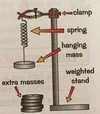Materials Flashcards
define Hooke’s law
the extension of an object is directly proportional to the force provided it hasn’t been extended beyond its elastic limit
on a graph, how do you know where the elatic limit is?
when the graph is no longer a straight line
if a spring obeys Hooke’s law, does it behave elastically or plastically?
elastically
if a spring is beyond Hooke’s law, does it behave elastically or plastically?
plastically
explain the meaning of elasticity
the object (e.g. the spring) return to its original state when the force is removed
explain the meaning of plasticity
the object will not return to its original state when the force is removed - it stays deformed
what does Hooke’s law look like graphically?
A is the elastic limit so the line is no longer straight afterwards

give an example of an everyday object that behaves elastically
hairband
give an example of an everyday object that behaves plastically
bluetac
over which range does the spring obey Hooke’s law?
summarise the characteristsics of the graph

range = 0N - 33N
elastic limit = A at 33N
until point A the graph is directly proportional: as the load increases, the extension increases in a proportional manner
after point A, the graph abandons the straight line and becomes curved
sketch a graph showing a single spring, a two springs in series and a two parallel springs being extended
A = single spring being extended
B = series spring being extended
C = parallel spring being extended

if a single spring (A) being extended has a gradient of 0.250 N/cm then calculate the gradient of two springs in series (B) and two parallel springs (C) being extended
A (single) = 0.250 N/cm
B (series) = 0.125 N/cm
C (parallel) = 0.500 N/cm

what is another word for strength of a spring?
stiffness
describe the relationship of A
gradient of A = 0.250 N/cm

as the load increases, the extension increases in a directy proportionally manner
the graph is linear with a straight line through the origin (directly proportional) with a gradient of 0.250 N/cm until point x where the extension increases more than the load increases
A obeys Hooke’s law as force and extension are directly proportional
however, it does not obey Hooke’s law at point x and beyond
describe the relationship of B
compare it to to A
gradient of A = 0.250 N/cm
gradient of B = 0.125 N/cm

in proportion to A, B’s gradient is halved (0.125 N/cm)
two springs in series are half the strength of a single spring
B’s graph is linear with a straight line through the origin showing it is directly proportional
B obeys Hooke’s law as the load (force) increases as the extension increases in a directly proportional manner







